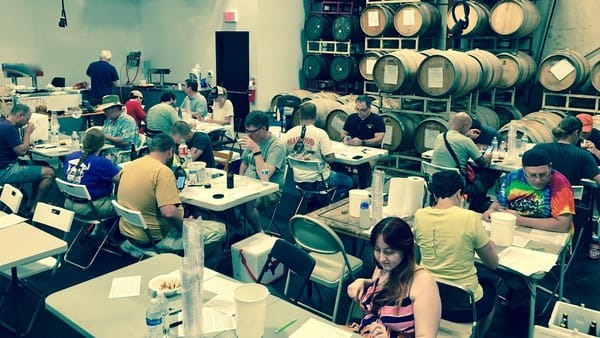Brewing Water Series: What is the Best Water?

I saw this title pop up on a forum post recently. It's an incredibly loaded question, and certainly something that opens up a good deal of debate. We are also going to have to accept a lot of subjectivity (my opinions) in this discussion.
The best water is that which will help put the very best beer in the glass, and there are many ways to get there. I feel like I have written this post many times, but all of the issues below need to be addressed, so maybe we should look at water from a different perspective.
1. Consistency. Knowing where to start with your water is very important if you are doing any mineral additions. So a brewer's water profile from a lab maybe necessary. But before you do that, answer this question:
Is my tap water consistent? This should address sources of the water supply and any seasonal issues, such as agricultural or road run off. Sanitation chemistry is also important. This information can be gleaned from a call to your municipal supply, their website or through periodic testing if you have a well.
Reverse Osmosis (RO) and De-Ionized/Distilled (DI) water provides a very consistent source, but will often require mineral additions for the all-grain brewer. However, you should test the source regularly for consistency. Bulk commercial water systems at grocery stores sometimes have inconsistent maintenance and home filter systems will require regular replacement of filters. The brewer must consider the costs and convenience. A TDS meter is an inexpensive solution and provides an indication of residual minerals and filter effectiveness. Bottled bulk water remains an excellent choice for brewing. Just remember that spring water contains some minerals that you may wish to account for in any mineralization for brewing.
Most whole home water softener systems will produce sodium or potassium rich water that is unsuitable for brewing. It is a great solution to feed a small RO system with a predictable hardness level.
2. Active Charcoal Filtration and Treatment. All municipal water carries some sanitation chemistry to ensure safety. While this chemistry may vary in strength, it is relatively easy to deal with. Chlorine and Chloramines will react with mash phosphates to form polyphenols, which express as bandaid, plastic or strong smoky flavors in beer.
Allowing the water to stand overnight, or pre-boiling should gas off chlorine products, but chloramines are much more stable than chlorine. Boiling brings other benefits, such as potentially lowering the water alkalinity, precipitating bicarbonates. This requires some planning ahead and uses fuel.
Slow filtration with active charcoal filters (you can find these at any home improvement store) will remove much of the chlorine and chloramine, as well as removing other chemistry that may affect flavor. The contact time with active charcoal is critical and we should be concerned with any residual chlorine/chloramine products after filtration, so a slow flow is required.
The most complete treatment is the use of Campden tablets or Metabisulfate (Sodium or Potassium). These products react nearly instantly with chlorine and chloramines to produce sulfur which gasses off quickly. The amounts required are very small, 1/4 tablet of Campden crushed will treat 5 gallons of tap water. These same chemicals are used as sanitizers and stabilizers in wine and mead making - but at much higher levels. Combined with active charcoal filtration, your tap water maybe perfectly suitable for brewing some beer styles.
3. Brewing Method. If you are an extract brewer, the extract already contains the necessary minerals. It is best then to use RO or DI water to avoid over mineralizing the beer. Minor adjustments can certainly be made, such as small amounts of gypsum for hoppy beers or calcium chloride for malt forward beers.
All grain brewers have different requirements. Mashing will require hitting a mash pH range (5.2 - 5.6) and water alkalinity has a very dramatic impact here. The use of RO/DI water will usually require some moderate adjustment of minerals. Without, the beer may seem flabby and lackluster. Judicious use of liquid acids or alkalis may be required.
Your source water's alkalinity (usually given as CaCO3) is the critical value. You can get this through lab testing, or you can also use an aquarium testing kit. This value will allow you to estimate the necessary acid/alkali required to strike a specific mash pH.
4. Complexity and Convenience. Even for all grain brewers, one can make this very complicated or very simple. The most important part, as mentioned is hitting the right mash pH. This will allow for full extraction of flavors and sugars from the malt. The rest is really a focus on nuancing a beer's desired mouthfeel and sharpness or roundness of malt and hop flavors.
Creating your own water at home or buying from the store all can have inconvenient elements. Decide what works for you, your time and budget. Figure out which will give you the best results.
Regardless of your brewing style, managing your brewing water is an important part of brewing. Water chemistry affects mash pH, boil pH and the formation of break material in the kettle. The residual -ion concentrations affect mouthfeel and enhances flavors.
Where to start? There are many guides on the internet that provide different approaches to this topic, including here at Accidentalis. Some are very complicated. Depending on your comfort with chemistry, you can go extremely technical or stick with the basics. Water chemistry is pretty fascinating.
I will warn that there is not a one-size-fits-all solution. Anyone selling you something that 'fixes' mash pH is ignoring the facts that not all water sources or grain bills are the same. Chuck that 5.2 pH buffer that your LHBS sold you into the trash and not in your mash.
Buy some gypsum and calcium chloride, as well as some lactic or phosphoric acid. Get some fresh baking soda and you have all of the minerals you need for basic water management. Save up to buy a decent pH meter, something with replaceable probes and learn to use it properly.
Start conservatively - you don't want minerally beer. Or maybe you do. You can treat finished beers with mineral solutions to figure out the levels you may like.
Do some research online. Visit the Homebrewtalk Brewing Water Primer for a simple place to start. Get your water tested and learn to use tools like the Bru'n Water Spreadsheet or Brewer's Friend Water Calculator. Use your new pH meter to confirm the estimates from those water calculators. Keep at it - brew and take good notes. Rebrew the same recipe with a different water profile. Note the differences. Find a mentor and brew together and enjoy the ride!
Prosit!




